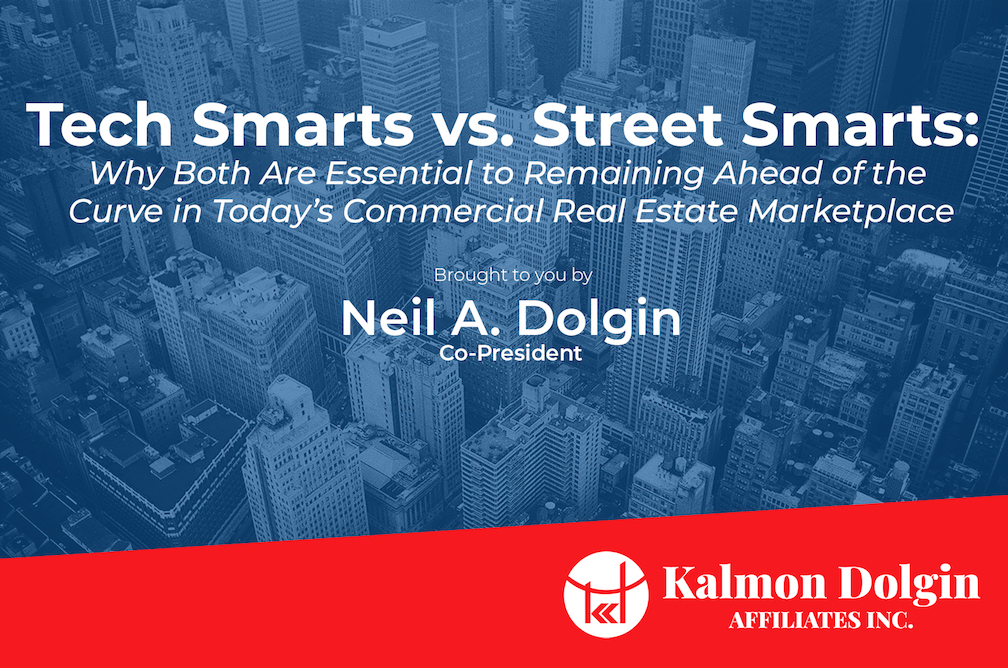by Neil A. Dolgin, Co-President
As with virtually every industry and aspect of our lives, commercial real estate continues to reap big benefits with the help of technology these days. From enhancing property research and corporate websites to more sophisticated customer relationship management (CRM) platforms, cloud storage, social media tools and the growing popularity of drones, “proptech” startups are raising more cash than ever.
At the same time, commercial real estate firms and landlords are increasingly adopting a broad range of new software and hardware that is changing the way they do business as never before. According to one statistic from the research firm CREtech, venture investors poured $12.9 billion into real estate tech startups during the first half of 2019 alone—already beating the $12.7 billion record for all of 2017.
But beyond these numbers, also consider some of the specific technologies and their respective benefits currently being utilized in a myriad of areas by many commercial and industrial real estate firms such as ours. Top CRE firms are using technology to enhance their capabilities for developing, managing, selling, leasing and marketing commercial and industrial property.
For example, CRE portals such as LoopNet, Reonomy, PropertyShark and many others have transformed the way we gather data on potential leads, thereby allowing us to better pinpoint properties for sale or for rent within specific neighborhoods. As somebody who also does appraisals, they enable me to do a cost analysis while giving me a better understanding of what the value of these properties could be. Additionally, a good number of these services list the names and phone numbers of the owners, which in turn, increases the personalization of the experience by eliminating much of the initial guesswork.
Advances in technology have also proven invaluable when it comes to property management both in terms of helping CRE professionals improve their operational efficiencies and gain better transparency over their properties. Similarly, the use of drones and other disruptive technologies have increasingly become go-to CRE marketing tools. Not only do these “virtual eyes in the sky” give detailed overviews of commercial and industrial real estate listings, they also make it possible for prospective tenants to inspect to properties, including hard-to-reach areas like the roof and crawl spaces. Yet another added value is mapping to help aggregate information related to a property’s surrounding amenities such as parking, public transportation, nearby restaurants and retail.
What makes CRE proptech really work for our brokers is when we effectively combine the benefits of technology with what I call “street smarts”. When I first entered my family’s business more than four decades ago, I was using phone books and index cards to find potential leads, and then I gained valuable experience and knowledge by visiting a neighborhood and meeting building owners and managers – being in the thick of it, getting a feel for the buildings and neighborhoods. In commercial real estate, this is also known as canvassing.
So, what does having “street smarts” actually mean, and why is street smarts a broker’s most indispensable personal technology? At its most basic, it means you have a solid understanding of what’s going on around inside and around a particular building and what else is available in the areas where you operate, so that you can serve your clients as effectively as possible.

Here are 4 Tips for Developing Your Personal Technology “Street Smarts”
- Hit the Streets. One of the most common mistakes that many new brokers make is trying to rent or sell a property without seeing it. How else can one assess whether a property is a good fit for a client’s long-term needs? Visiting a property helps one determine how well a property may meet a clients needs even before showing it. You can validate the information an owner gives us about a property and the specs that appear online. While in the neighborhood, you can also knock on doors, pass out flyers and meet with other landlords, so you acquire the most current information to give to your clients about the building and surrounding neighborhood. This can include everything from the types of tenants who are in a building to what the neighborhood is really like.
- Clients Often Mis-Estimate Needs. “Street smarts” also comes into play when clients are growing and think they need more space than they actually do. For example, let’s say a client tells me they need 20,000 square feet and they’re coming out of 5,000 sq. ft. Nine times out of ten, they only need about half of that and when I take them to see the property it ends up being too big because they don’t understand square footage in terms of heights and widths. If a broker has canvassed well, he’ll have a range of different building choices based on one’s knowledge of a neighborhood combined with online information.
- Face-to-Face is Key — Just as it’s crucial to see a property and meet with an owner before you begin showing it to clients, it is also essential to visit a prospective tenant. See where their business is currently located and gain a broader understanding of what their needs might be. Face-to-Face discussion helps to ensure that no opportunity is overlooked. Combine this with combine the specialized information gathered through canvassing and CRE tools, and we have the best chance of meeting their needs. This kind of personalized approach ensures the best results for all parties.
- Flaws Exist in Online Listing Data. Although online listings portals have improved significantly, many CRE firms and owners fail to regularly update their properties online, which is why competing brokers often have to deal with online information that is inaccurate or out of date.
As CRE proptech becomes more advanced and its implementation more cost-effective, technology still has to work hand in hand with street smarts. It isn’t about just knowing the data; it’s knowing the buildings, where clients are coming from, what they have and what they want. All these things require a face-to-face human touch and that’s why street smarts will always be a CRE broker’s most valuable personal technology.

Neil A. Dolgin is co-president of Kalmon Dolgin Affiliates. Founded in 1904, Kalmon Dolgin Affiliates (KDA) has grown into one of the New York metropolitan region’s leading commercial and industrial real estate firms. Kalmon Dolgin Affiliates specialize in all aspects of real estate services for developing, managing, selling, leasing and marketing commercial and industrial property. KDA’s highly-trained professional brokers offer clients a practical, street-wise approach to commercial and industrial real estate brokerage, leasing and sales, supported by the latest in real estate marketing, management and research technology.

